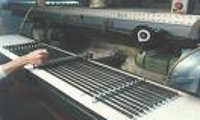The Three Ways to Make a graphite shaft
There are three commonly used methods to produce a graphite shaft: the tested and proven sheet lamination process, the seamless filament winding process, and the resin transfer molding process, that is frequently used to mould irregular-shaped parts.
The question that faces clubmakers and golfers, is, which one makes the best performing graphite shaft? Before an answer can be found, we need to examine the design and production process behind each one of these approaches to shaft making.
In the sheet lamination process, unidirectional ply and angular ply of graphite prepreg (i.e. a thin and flat sheet of graphite fiber bonded together with epoxy resin) are laminated over a steel mandrel to achieve the desired level of strength, stiffness, torque, weight, and kick point. Some suggest that sheet laminated shafts are not seamless, and hence, not as good. A good shaft designer knows how to design a sheet laminated shaft that demonstrates the same frequency uniformity as a filament wound or a RTM shaft
In the filament winding process, the process involves winding filaments under varying amounts of tension over a male mould or mandrel. The mandrels rotates while a carriage moves horizontally, laying down fibers in the desired pattern of our choice. Each shaft uses only high modulus filaments, consisting of carbon fibers that are coated with synthetic resin, and or Nano fillers, as they are wound. Once the mandrel is completely covered to our desired thickness, the mandrel is placed in an oven to solidify (set) the resin. Once the resin has cured, the mandrel is removed, leaving the hollow shaft ready for paint and graphics. The shaft can be made as an overlong blank universal shaft, then portions of the butt and tip of the shaft can be trimmed to produce a desired shaft length and natural frequency of vibration
In the resin transfer molding (RTM) process, the shaft maker first needs to design a graphite sleeve braided with a multi-axial braiding machine. The mandrel is then inserted inside the sleeve, and placed inside a two part mould, and when clamped together creates a female cavity of a shaft. Finally, epoxy resin is injected inside the mould with 135 psi pressure, and the shaft is heated to cure. The RTM process, using braided sleeves is a process that is ideal for making irregular-shaped product. When it comes to designing tubular product, the RTM process is not as versatile as the lamination process. The resin distribution is also not as even as the lamination process. The bottom line is when you can use sheet lamination or filament winding process to make a cheaper and better shaft, why would you use RTM?

|

|
| sheet lamination process | filament wound |

|

|
| sheet laminating process | filament winding machine |
All three of the processes have their respective strengths and weaknesses. The challenge for any shaft maker is to determine what kind of material to use, how the material should be used, how to design the tooling, and finally how to control the production process as to produce the optimal graphite shaft at the best price.
Golf Club Technology uses mostly filament wound driver shafts in their custom drivers, produced from the top names in the industry. These shafts run from $150.00 to $200.00 installed, and we will install some of the more expensive graphite shafts on a custom basis, but we have found that the middle price ranges, are the best buy and are easily custom fitted.